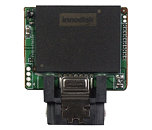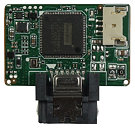Friday, September 25th 2015
Innodisk Announces New Cable-Less SATA Power Technology for Disk-On-Module SSDs
Innodisk, the service-driven flash provider, announces its latest series of SATADOM disk-on-module SSDs featuring a new cable-less power technology. This latest series of SATADOM and ServerDOM come in the same compact form factor but feature a new way of delivering power to the flash drive directly through the SATA connector itself for less clutter and superior reliability. The new patented Pin 8 technology powers a series of SATADOM drives which will come in a variety of compact form factors and flash flavors including SLC, MLC and iSLC, as well as DRAM-less versions for 100% data integrity in the face of power loss. Besides SATADOM with Pin 8 Technology, Innodisk is updating its full line of SATADOM SSDs including SATADOM powered by Pin 7 power and external power cables. The new SATADOM SSDs will feature higher capacities and DRAM-Less SSD technology.
Patented by Innodisk, SATA Pin 8 Vcc uses the SATA connector itself as a power supply to drive the device without external cables. Extra pins on each side of the drive's connector mate with pins in the motherboard's SATA interface to provide a power source that eliminates the need for cables. Already available on motherboards from top manufacturers, Innodisk's Pin 8 Vcc technology joins Innodisk's SATA Pin 7 Vcc technology to enable compact, cableless SATA storage solutions.Reliable Cable-Less Storage
SATA Pin 8 Vcc Technology makes SATADOM the ultimate plug and play storage with no extra connectors needed. It not only provides power but the SATA connector's power pins create a robust physical connection between the SSD and motherboard, increasing system reliability. The robust cableless design means less clutter and improves air flow, especially in rackmount server chassis and low profile system.
The Perfect Server OS Storage
With its small form factor, industrial grade technologies and reliable power sourcing, SATADOM provides the perfect compact flash storage for servers, and also comes in an even more compact ServerDOM version especially designed for server applications. For high storage reliability, ServerDOM is compatible with Intel RSTe technology and can be configured as a pair of SSD Boot drives for OS redundancy. With its cable-less design, SATADOM is easily hot swappable with no extra connections to deal with. Using ultra-compact Innodisk nanoSSD flash, ServerDOM has a slim form factor that fits into some of the most low-profile rackmount and blade chassis for compact, reliable storage that eliminates messy cabling.
Patented by Innodisk, SATA Pin 8 Vcc uses the SATA connector itself as a power supply to drive the device without external cables. Extra pins on each side of the drive's connector mate with pins in the motherboard's SATA interface to provide a power source that eliminates the need for cables. Already available on motherboards from top manufacturers, Innodisk's Pin 8 Vcc technology joins Innodisk's SATA Pin 7 Vcc technology to enable compact, cableless SATA storage solutions.Reliable Cable-Less Storage
SATA Pin 8 Vcc Technology makes SATADOM the ultimate plug and play storage with no extra connectors needed. It not only provides power but the SATA connector's power pins create a robust physical connection between the SSD and motherboard, increasing system reliability. The robust cableless design means less clutter and improves air flow, especially in rackmount server chassis and low profile system.
The Perfect Server OS Storage
With its small form factor, industrial grade technologies and reliable power sourcing, SATADOM provides the perfect compact flash storage for servers, and also comes in an even more compact ServerDOM version especially designed for server applications. For high storage reliability, ServerDOM is compatible with Intel RSTe technology and can be configured as a pair of SSD Boot drives for OS redundancy. With its cable-less design, SATADOM is easily hot swappable with no extra connections to deal with. Using ultra-compact Innodisk nanoSSD flash, ServerDOM has a slim form factor that fits into some of the most low-profile rackmount and blade chassis for compact, reliable storage that eliminates messy cabling.


18 Comments on Innodisk Announces New Cable-Less SATA Power Technology for Disk-On-Module SSDs
I think we're past due for a new standard post ATX/BTX/ITX. 12V is way too much power for modern CPUs, for example.
I wish esata would've taken off more and had a better standard to it that would've allowed for single connection power and data. And maybe crosstalk was the issue...my interest is perked... Time to research.
:toast:
Back on topic: I don't know why servers would use this over, say, M.2 slots.
That was very understated in the OP as some year-old motherboards have these ports. With a head-start over the still maturing M.2 it may be chosen due to greater availability. If you're in one of the intended markets they're also not bad :) Get 64GB at 530/185 R/W for $90 USD.
M.2 will eventually win out due to greater versatility but until then Innodisk just wants to maximize return for all those that have invested in it already.
I don't think I've seen any motherboards with the SATADOM port. M.2 is already very common in new mid-and-better boards.
Don't have a complete count yet but I'm already past 30 models at Supermicro alone, found on 1P, 2P, and 4P boards. They of course brand them SuperDOM because, well, that's what they do.
I'd be doing better with Asus if the site wasn't so slow for me right now. I know boards like the Z97-WS and others have M.2 and I don't recall off the top of my head if any have SATADOM Pin 7/Pin 8 support.
Gigabyte has some with both DOM and M.2, though the DOM has Pin 7 power design not the new Pin 8. An excerpt from MW50-SV0 manual:
Little wonder why Pin 7 didn't catch on, with jumpers or auto-detect necessary for operation.
SupreMicro = server boards = why I haven't heard of it (not staying up on those because not in the market)
Z97-WS I assume means WorkStation so the same market.
It's kind of hard to tell on that schematic how many SATA DOM it has...4 of them? It's kind of hard to tell where they are too but having 8 DIMMs tells me it is a workstation board too.
I'm getting the strong impression that SATA DOM hasn't infiltrated the consumer market at all where M.2 has.
Correct me if I'm wrong but if they added a 7th pin, it wouldn't be backwards compatible with normal SATA ports. That's why I'm saying SATA needs to be updated, from the ground up, and do away with the SATA power connector.
My Z170 board has two of them at 2 GB/s each. It's designed specifically for the next generation of SSDs. SATA Express still has the advantage of being able to fit a much larger device than M.2/U.2. My point in that rant is that SATA Express is just as sloppy as it having the 3.3v pins. We need a SATA2 spec.
I only noticed this because I tried to run it in a laptop with a big drive bay (it is a 2.5" HD) and it refused due to the 3.3v line missing. I then read the drive label and was surprised to find this drive requires the whole gamut supported by the SATA power connector specs. Only quality desktop PSUs seem to actually reliably implement the 3.3v required.
Oh and the fruity firm will claim prior Art/Patent and will Sue the dog and its Bollocks